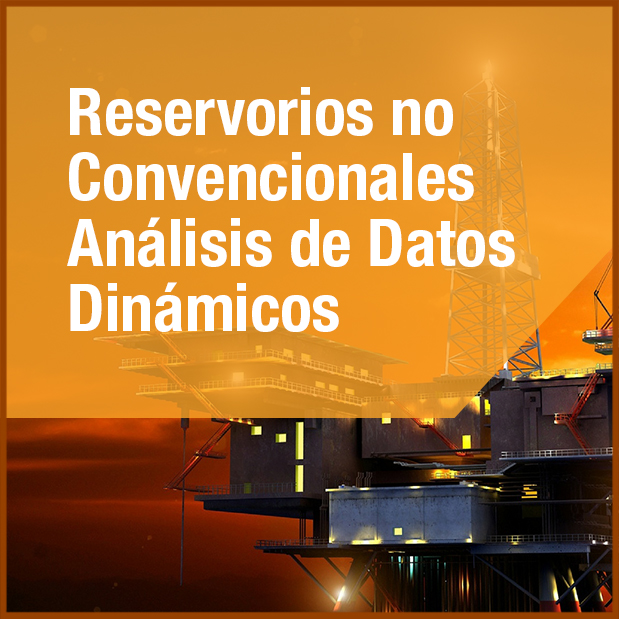
LENGUAJE: ESPAÑOL
DURACIÓN: 2 horas Aprox.
COSTO: 150 USD
Se presenta una introducción a los métodos de interpretación de datos de presión transiente aplicados a pozos inyectores de agua o polímeros a fin de obtener un conocimiento básico de la metodología corrientemente aplicada para el análisis de los datos de presión adquiridos durante el cierre de la inyección, pruebas comúnmente denominadas de falloff. La teoría se complementa con ejercicios aplicando programa comercial especializado en el tema.
El curso se presenta en dos videos cuyos contenidos se detallan a continuación.
Video Primera Parte (74 minutos)
- Introducción. Producción por primaria y secundaria.
- Pruebas de Inyectividad y Falloff.
- Entorno geológico y de reservorio.
- Prueba Falloff. Adquisición de los datos de presión.
- Interpretación de los datos.
- Soluciones analíticas: Modelo Radial Compuesto y Multibancos.
Video Segunda Parte (46 minutos)
- Soluciones Numéricas: Consideración del perfil de saturaciones en el reservorio.
- Ejemplos de análisis.
- Desarrollo de Reservas por Primaria y Recuperación Secundaria.

LENGUAGE: ENGLISH
DURATION: 21 minutes
COURSE COST: 40 USD
A basic pressure transient analysis is presented for the case of a multirate well test carried out in a vertical exploratory well.
Main learning idea is to get a quick overview on current well test analysis also referred as PTA methodology.
Main testing objectives to be derived from the analysis are to prove well potential and to confirm seismic and geological models.
Flow regimes identification as well as possible reservoir models or solutions to simulate the acquired pressure data are presented. Both conventional and deconvolution methods are used.
Interpretation methodology is shown step by step and it is complemented by the application of a premium commercial software.

LENGUAGE: ENGLISH
DURATION: 3 hours aprox.
COURSE COST: 190 USD
The interpretation methods commonly used to analyze pressure data acquired in injector wells are presented. For the sake of completeness, a brief introduction to well test analysis methodology including machine learning models is also given for a proper understanding of its application in the case of injector rather than producer wells. Falloff test interpretation methods for either water or polymer injector wells is included.
Course is given in seven videos. It follows Video’s content
Video Section 1 (31 minutes)
- Introduction
- Well testing overview
- Introduction
- Testing Exploratory wells
- Types of Well Tests
- Well Testing Program
Video Section 2 (34 min)
- Basic Interpretation Process
- Unconventional Reservoirs
- Machine Learning
Video section 3 (20 min)
- Pressure Transient Analysis-Example
Video Section 4 (20 min)
- njectivity and Falloff testing
- eological and reservoir environment
- ressure data acquisition
Video section 5 (26 min)
- Basic mathematical model development
- Radial composite and multibank models’ solutions
- Analysis examples
Video Section 6 (22 min)
- EOR Applications
- Analytical modelling flow of non-Newtonian (polymer) and Newtonian fluids
- Hall Plot
Video Section 7 (31 min)
- Numerical nonlinear solution
- Analysis examples
- Reserves development by primary and secondary recovery – a simulation example
- Course Summary

LENGUAJE: ESPAÑOL
DURACIÓN: 3 horas Aprox.
COSTO: 200 USD
Se detalla brevemente la evolución histórica a partir de la década del año 1950 hasta el presente, de los métodos más relevantes usados para el análisis: Horner, curvas tipo, derivativa y deconvolución, así como se presentan las soluciones tanto analíticas como numéricas, lineales o no lineales, incluyendo metodología basada en aprendizaje automático (Machine Learning) aplicadas para la interpretación de los datos de presión adquiridos en pozos completados en reservorios convencionales, así como no convencionales (NOC). La teoría se complementa con ejercicios aplicando programa comercial especializado en el tema.
El curso se presenta en cuatro videos cuyos contenidos se detallan a continuación.
Video Sección A (1 hora)
- Sistemas de Medición.
- Métodos de Interpretación-Desarrollo Histórico.
Video Sección B (43 minutos)
- Métodos Analíticos y Numéricos.
Video Sección C (25 minutos)
- Deconvolución.
Video Sección D (42 minutos)
- Inteligencia Artificial.
- No convencionales (NOC).

LENGUAGE: ENGLISH
TOTAL DURATION (12 VIDEOS): 5.25 hours
COURSE COST: 240 USD if acquiring all 12 VIDEOS or 30 USD/VIDEO
The process of interpreting pressure transient data acquired during a well testing job is presented for 12 examples which are quite representative of field cases. Main idea is to share interpretation knowledge by looking at pressure transient data analysis done to different type of tests, well completions, and reservoirs.
Data Interpretation has been carried out applying a commercial software, Saphir under a license acquired from Kappa Engineering. Total presentation is delivered in 12 videos, one for each example. You may acquire all 12 examples or just the ones you like. In any case you will have my assistance on line if needed. It follows test type and analysis highlights as well as video’s duration. (minutes)
VIDEO 1 Introduction and Example 1 (37)
- Multirate test done in a well completed in an oil reservoir. Results from deconvolution approach in agreement with one event analysis. Fault identification is consistent with seismic model.
VIDEO 2 Example 2 (26)
- Multirate type of test done in a high permeability gas reservoir. A discussion on skin dependent on either time or rate or both is presented.
VIDEO 3 Example 3 (29)
- Modified isochronal test done in a slanted, 500 well completed in a gas condensate reservoir. Mechanical, slanted and turbulence skin components are derived.
VIDEO 4 Example 4 (15)
- Multirate type of test done in an oil reservoir. Derived model using buildup analysis, is not in agreement with deconvolved pressure analysis.
VIDEO 5 Example 5 (23)
- Buildup test done in a well completed in a high pressure and low permeability oil reservoir. Not a unique simulation model. Skin dependance on time.
VIDEO 6 Example 6 (27)
- Multirate test. Water and oil are the producing fluids. Both a homogeneous reservoir model with a leakage fault and a radial composite reservoir match he pressure data.
VIDEO 7 Example 7 (17)
- Minifrac test, also called DFIT, Instantaneous shut-in pressure (ISIP), closure fracture pressure and time, reservoir initial pressure and far field permeability are derived from the analysis.
VIDEO 8 Example 8 (22)
- Interference, effect on buildup and falloff tests conducted in a well completed in a homogenous oil reservoir. Pressures acquired during primary and secondary recovery stages.
VIDEO 9 Example 9 (43)
- Interference, effect on buildup and falloff tests conducted in a well completed in a fractured oil reservoir (two porosity) Pressures acquired during primary and secondary recovery stages.
VIDEO 10 Example 10 (23)
- Multirate type of test done in an oil reservoir. Derived model using buildup analysis, is not in agreement with deconvolved pressure analysis.
VIDEO 11 Example 11 (26)
- Multirate test in a limited entry oil well. Spherical and radial flow are identified as well as discontinuities. Deconvolution method prove to be valuable in defining limit nature.
VIDEO 12 Example 12 (27)
- Production. Rate transient analysis (RTA) as well as decline curve analysis (DCA) applied to a multifractured horizonal well completed in an unconventional gas reservoir. Expected EUR according to available models.

LENGUAJE: ESPAÑOL
DURACIÓN: 4.35 horas.
COSTO: 190 USD
Este curso provee un conocimiento básico de los métodos de evaluación dinámica usados para evaluar la productividad de los pozos y la declinación de la producción en reservorios no convencionales. La interpretación de los datos se realiza aplicando el software Saphir que está incluido en KAPPA-Workstation bajo licencia adquirida a Kappa Engineering.
La entrega del curso se hace en 5 videos cuyos contenidos se presentan a continuación.
VIDEO 1 RESERVORIOS NO CONVENCIONALES (68 min)
- Introducción a los reservorios no convencionales
- Tecnologías usadas en la detección de la configuración y geometría de las fracturas y volumen de reservorio estimulado (VRE)
- Modelos de reservorio
- Análisis de Pruebas tipo Minifrac (DFIT)
VIDEO 2 ASPECTOS GEOMECÁNICOS (46 min)
- Esfuerzo Horizontal.
- Apertura de Fracturas Naturales Durante el Fracturamiento Hidráulico.
- Efecto geo mecánico - Dependencia de la permeabilidad y porosidad con la presión.
- Consideraciones Generales de Producción del Pozo.
VIDEO 3 ANÁLISIS DEL PERIODO DE FLOWBACK (41 min)
- Consideraciones técnicas del Periodo de Flowback en Pozos hidráulicamente Fracturados.
- Mecanismos que pueden inducir daño y el impacto del choke o drawdown management en la productividad.
- Presión de fondo y esfuerzo neto.
VIDEO 4 REGÍMENES DE FLUJO (53 min)
- Regímenes y Estados de Flujo Presentes en reservorios no convencionales.
- Diagnostico tipo RNP (Rate Normalized Pressure).
- Solución a la Presión de fondo fluyente
- Diagnóstico de productividad del reservorio.
VIDEO 5 TRANSIENTES DE CAUDAL (RTA) Y DECLINATORIA DE LA PRODUCCION (DCA) (53 min)
- Métodos de Análisis de Declinatoria. Desarrollo Histórico.
- Graficas de diagnóstico sugeridas para el análisis de la declinatoria.
- Análisis de Caudal y Presión Transiente Basado en el Grupo CHOW
- PVT: Densidad y Viscosidad en No convencionales.



